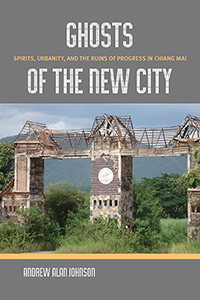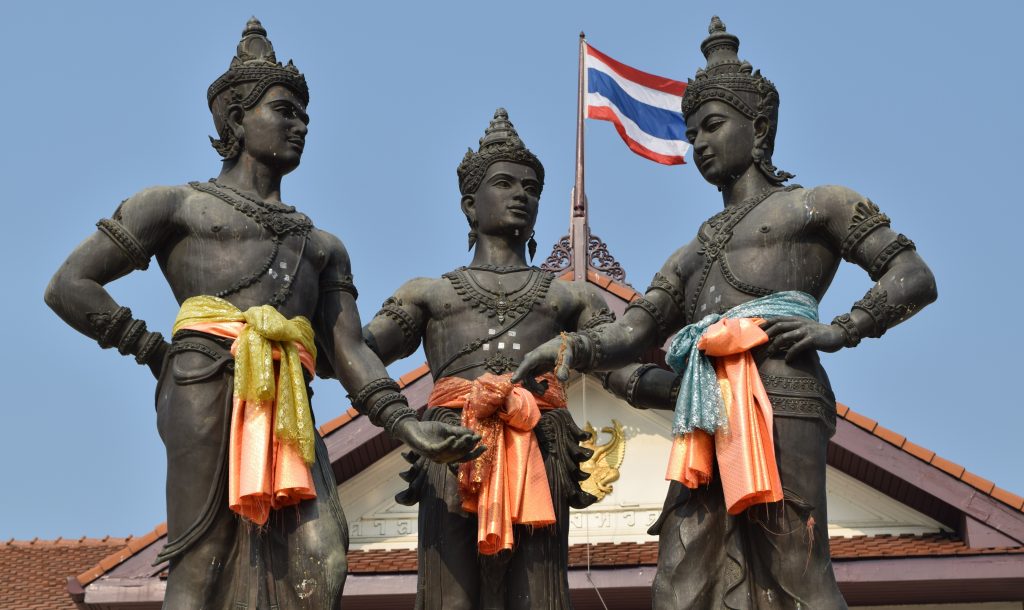 Andrew Alan Johnson, Ghosts of the new city: Spirits, urbanity, and the ruins of progress in Chiang Mai, (Honolulu: University of Hawaii Press, 2014)
Andrew Alan Johnson, Ghosts of the new city: Spirits, urbanity, and the ruins of progress in Chiang Mai, (Honolulu: University of Hawaii Press, 2014)
Reviewed by Tim Forsyth
This colourful and detailed book analyses how Thailand’s northern capital of Chiang Mai is struggling with progress. In the short term, this struggle refers to the boom-and-bust building spree during the 1990s that left the city with unfinished and empty hotels and housing estates after the Asian financial crisis. In longer terms, the struggle is also the challenge for understanding tradition in the face of modernisation.
At the simplest level, this book presents anecdotes and information about northern Thai culture, and especially how people of Chiang Mai have understood cultural authority in leaders and in rituals. This content should be of interest to any scholars of Thai culture. More academically, the book forms part of a trend in urban studies to illustrate the role of culture in connecting premodern and modern expressions of power.
The first, and most arresting theme, are the ghosts mentioned in the book’s title.
Johnson describes how Chiang Mai residents believe that ghosts inhabit the buildings left empty by the boom, and that these “spirits, unable to be reborn… and buildings crumbling in the heat are all linked to the inability of the city to progress” (p 6).
These stories often make for disturbing reading. In particular, the ghosts are what Thai people call phi tai hong—or “ghosts of bad death” (p 19). In one anecdote, a tall apartment building on canal road—an ugly, fast road in the north of the city—is now badly cracked and stained with car exhaust fumes. A young girl was struck by a car and died outside the building. Later, in the same building, a teacher shot himself in the mouth (p5).
Johnson notes how the trend to think of ghosts and tortured people matches a national obsession with films on the same theme. The 2010 film Laddaland (Golden Land), for example, shows how a successful Thai man moves from Bangkok to a Chiang Mai gated community with manicured lawns. By the end of the film, the man’s business collapses, he suspects his wife of infidelity, and—thinking him to be a malevolent ghost—he accidentally shoots his own son (p 7).
Mercifully, the writing shifts quickly to explaining the background to cultural traditions in Chiang Mai. In particular, the book discusses barami, or locally respected forms of charisma and influence that provide cultural authority. Johnson argues “the haunting of Chiang Mai’s abandoned architecture points to a failure in the system of charisma and power” (p 6). As part of this historical analysis, he reviews various activities and rituals that have made barami, including Chiang Mai’s famous monument to the Three Kings (Mangrai, Ngammueang, and Phra Ruang) in the centre of the city. The selection of these Kings as symbolic of Chiang Mai established different aspects of political and cultural authority. This authority persists today, such as through annual offerings of fruit, cash, bowls of Fanta, and whole pigs’ heads to the monument (pp 65-67). Premodern forms of power, therefore, have immense significance.
Another theme is the activities of mediums, who are people who act as intermediaries between traditional spirits and rites, and current activities. These mediums undertake rituals known as yok khru (“raising the teacher”), where the “teacher” might be a spirit of the Three Kings, or one linked to the city gates, or other landmarks (p 72). Mediums might also participate in acts to “make rain” after drought, which Johnson argues is also a metaphor for prosperity (pp 73 and 148).
Against these premodern concerns lie Chiang Mai’s rapid growth and transition to tourism and housing for Thailand’s new rich classes. The premodern cultural order and neoliberal expansion seem destined for tension. For example, the city’s first high-rise condominium went up on the banks of the River Ping in 1985, followed by 10 further condominium projects in 1989 (p 130). Various complaints followed: about the pollution or over-use of water, but also that “to build living quarters where people would eat, sleep, eat, defecate, have sex, and the like looming above the spires of Buddhist temples or animist spirit shrines… was an affront and potentially dangerous” (p 130). In the 1980s, renovations to the city were also blamed for helping to spread AIDS (p 64).
A different kind of concern was also expressed about so-called mega projects inspired by Chiang Mai’s most influential politician, Thaksin, such as the Ratchaphruek flower garden and Golden Hall south of Chiang Mai airport (p 116). This location, with royal patronage, also provided a symbolic connection of Lanna (ie northern Thailand)’s historic kings with the national, Thai, monarchy. Each has different styles of barami (p 126).
Such new developments also point to the potential use of faux Lanna style—or the reproduction of historic forms of Chiang Mai architecture for modern activities such as tourism, housing estates, or “nationalist and royalist readings of culture and history” (p 136). According to some observers, the misuse of cultural symbols could have consequences. Johnson describes how one informant expressed concern about the mass production of Buddhist amulets for tourists, in a way that evoked “nationalism, the risk posed by globalisation, and an assertion of a certain kind of revisionist Buddhist belief” (p 137).
Johnson’s argument is that these tensions have made a tense, and unfulfilled, Chiang Mai. He illustrates this argument with the common observation from Chiang Mai’s citizens that the city is phatthana tae yang mai charoen (“developed but not yet progressed”) (p 9 and 156). If cities are to be considered a site of symbolic power, then they can also illustrate the uneasiness about the future when viewed from the perspective of the past. Johnson argues that development needs to be permanent, wise and lasting, rather than fleeting and hollow (p 156). This is not happening in Chiang Mai. Accordingly, “the foundations are bad. The buildings are cracking. Ghosts come in” (p 6).
Students of Thai culture should find this book provocative and highly informative. Specialists in urban studies should also find this book a valuable example of analysing urban development through the perspective of culture.
Dr Tim Forsyth is Professor of Environment and Development at the London School of Economics and Political Science.
“Ghosts of the new city” is available from the University of Hawai’i Press.
 Facebook
Facebook  Twitter
Twitter  Soundcloud
Soundcloud  Youtube
Youtube  Rss
Rss 